ECONOMY Dictates B ody Design
Page 68
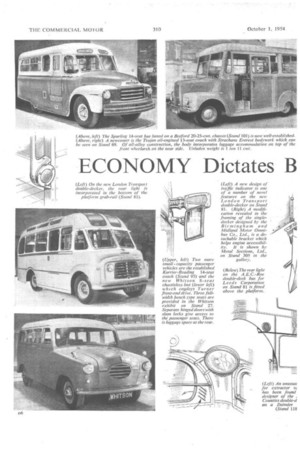
Page 69
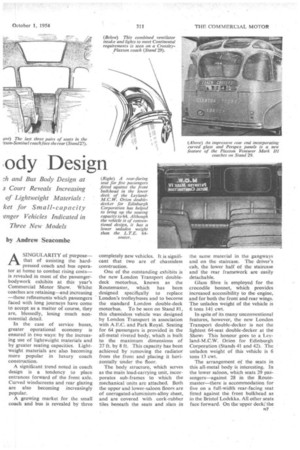
Page 70
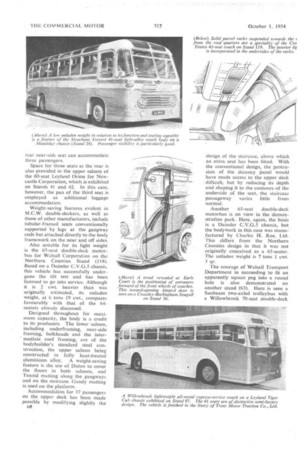
Page 71
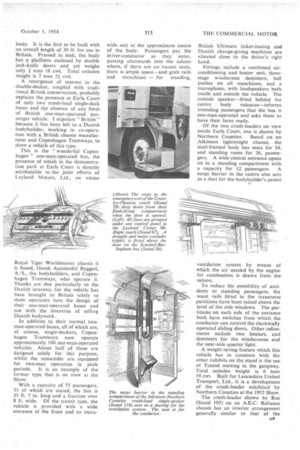
Page 72
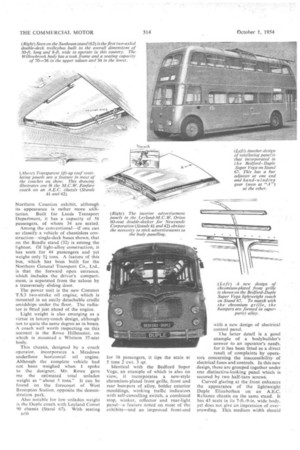
Page 73
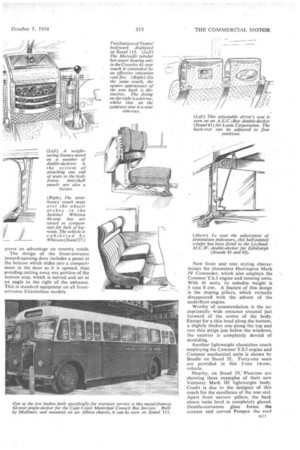
Page 74
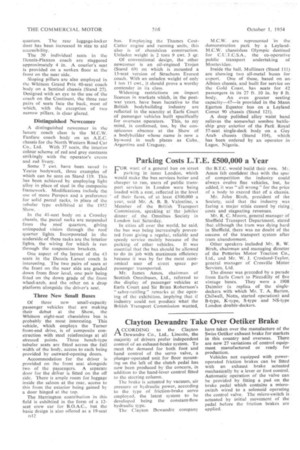
If you've noticed an error in this article please click here to report it so we can fix it.
12 and Bus Body Design at s Court Reveals Increasing of Lightweight Materials : ket for Small-capacity enger Vehicles Indicated in Three New Models
by Andrew Seacombe
ASINGULARITY of purpose-that of assisting the hardpressed coach and bus operator at home to combat rising costs— is revealed in most of the passengerbodywork exhibits at this year's Commercial Motor Show. Whilst coaches are retaining—and increasing —those refinements which passengers faced with long journeys have come to accept as a matter of course, they are, blessedly, losing much nonessential detail.
In the case of service buses, greater operational economy is ensured in two ways: by the increasing use of lightweight materials and by greater seating capacities. Lightweight materials are also becoming more popular in luxury coach construction.
A significant trend noted in coach design is a tendency to place entrances forward of the front axle. Curved Windscreens and rear glazing are also becoming increasingly popular.
A growing market for the small coach and bus is revealed by three completely new vehicles. It is significant that two are of chassisless construction.
One of the outstanding exhibits is the new London Transport doubledeck motorbus, known as the Routemaster, which has been designed specifically to replace London's trolleybuses and to become the standard London double-deck motorbus. To be seen on Stand 81, this chassisless vehicle was designed by London Transport in association with A.E.C. and Park Royal. Seating for 64 passengers is provided in the all-metal riveted body, which is built to the maximum dimensions of 27 ft. by 8 ft. This capacity has been achieved by removing the radiator from the front and placing it horizontally under the floor.
The body structure, which serves as the main load-carrying unit, incorporates sub-frames to which the mechanical units are attached. Both the upper and lower-saloon floors are of corrugated-aluminium-alloy sheet, and are covered with cork-rubber tiles beneath the seats and slats in the same material in the gangways and on the staircase. The driver's cab,. the lower half of the staircase and the rear framework are easily detachable.
Glass fibre is employed for the crocodile bonnet, which provides increased accessibility to the engine, and for both the front and rear wings. The unladen weight of the vehicle is 6 tons 144cwt.
In spite of its many unconventional features, however, the new London Transport double-decker is not the lightest 64-seat double-decker at the Show: This honour goes to a Leyland-M.C.W. Orion for Edinburgh Corporation (Stands 41 and 42). The unladen weight of this vehicle is 6 tons 13 cwt.
The arrangement of the seats in this all-metal body is interesting. In the lower saloon, which seats 29 passengers—against 28 in the Routemaster—there is accommodation for five on a full-width rear-facing seat fitted against the front bulkhead as in the Bristol Lodekka. All other seats face forward. On the upper deck/,' the rear near-side seat can accommodate three passengers.
Space for three seats at the rear is also provided in the upper saloon of the 60-seat Leyland Orion for Newcastle Corporation, which is exhibited on Stands 41 and 42. In this case, however, the pan of the third seat is employed as additional luggage accommodation.
Weight-saving features evident in M.C.W. double-deckers, as well as those of other manufacturers, include tubular-framed seats conventionally supported by legs at the gangway ends but attached directly to the body framework on the near and off sides.
Also notable for its light weight is the 65-seat double-deck motorbus for Walsall Corporation on the Northern Counties Stand (118). Based on a Daimler C.V.G.5 chassis, this vehicle has successfully undergone the tilt test and has been licensed to go into service. Although it is 2 cwt. heavier than was originally estimated, its unladen weight, at 6 tons 19 cwt., compares favourably with that of the 64seaters already discussed.
Designed throughout for maximum capacity, the body is a credit to its producers. The lower saloon, including underframing, near-side framing, bulkheads and the intermediate roof framing, are of the bodybuilder's standard steel construction, the upper saloon being constructed in fully heat-treated aluminium alloy. A weight-saving feature is the use of Dulon to cover the floors in both saloons, and Tenoid matting along the gangways and on the staircase. Gandy matting is used on the platform.
Accommodation for 37 passengers on the upper deck has been made possible by modifying slightly the D8
design of the staircase, above which an extra seat has been -fitted. With the conventional design, the protrusion of the decency Panel would have made access to the upper deck . difficult, but by reducing its depth and shaping it to the contours of the underside of the seat, the staircase passageway varies little from normal.
Another 65-seat double-deck motorbus is on view in the demonstration park. Here, again, the basis is a Daimler C.V.G.5 chassis, but the bodywork in this case was manufactured by Charles H. Roe, Ltd. This differs from the Northern Counties design in that it was not originally conceived as a 65-seater. The unladen weight is 7 tons 1 cwt. 3 qr.
The courage of Walsall Transport Department in succeeding to fit an apparently square peg into a round hole is also demonstrated on another stand (63). Here is seen a Sunbeam two-axled trolleybus with a Willowbrook 70-seat double-deck body. It is the first to be built with . an overall length of 30 ft. for use in Britain. Framed in teak, the body has a platform enclosed by double jack-knife doors and yet weighs only 2 tons 18 cwt. Total unladen weight is 7 tons 5i cwt.
A resurgence of interest in the -double-decker, coupled with traditional British conservatism, probably explains the presence at Earls Court of only two crush-load single-deck buses and the absence of any form of British one-man-operated passenger vehicle. I stipulate " British " because it has been left to a Danish bodybuilder, working in co-operation with a British chassis manufacturer and Copenhagen Tramways, to show a vehicle of this type.
This is the "wonderful Copenhagen" one-man-operated bus, the presence of which in the demonstration park at Earls Court is directly attributable to the joint efforts of Leyland Motors, Ltd., on whose
Royal Tiger Worldm aster chassis it is based, Dansk Automobil Byggeri, A/S., the bodybuilders, and Copenhagen Tramways, who operate it. Thanks are due particularly to the Danish-interests, for the vehicle has been brought to Britain solely to show operators here the design of their one-man-operated buses and not with the intention of selling Danish bodywork.
In addition to their normal twoman-operated buses, all of which are, of course, single-deckers, Copenhagen Tramways now operate . approximately 100 one-man-operated vehicles. About half of these are designed solely for this purpose, whilst the remainder are equipped for two-man operation in peak periods. It is an example of the former type that is on view at the Show.
With a capacity of 75 passengers, 33 of which are seated, the bus is 35 ft. 7 in. long and a fraction over 8 ft. wide. Of the transit type, the vehicle is provided with a wide entrance at the front and an extra wide exit at the approximate centre of the body. Passengers pay the driver-conductor as they enter, passing afterwards into the saloon where, if there are no vacant seats, there is ample space—and grab rails and stanchions — for standing. British Ultimate ticket-issuing and Danish change-giving machines are situated close to the driver's right hand.
Fittings include a combined airconditioning and heater unit, threestage windscreen demisters, bell pushes on all stanchions, and a microphone, with loudspeakers both inside and outside the vehicle. The outside speaker—fitted behind the centre body valances—informs intending passengers that the bus is one-man-operated and asks them to have their fares ready.
Of the two crush-loaders on view inside Earls Court, one is shown by Northern Counties. Based on an Atkinson lightweight chassis, the steel-framed body has seats for 34, and standing room for 26, passengers. A wide central entrance opens on to a standing compartment with a capacity for 12 passengers. A surge barrier in the centre also acts as a duct for the bodybuilder's patent ventilation system by means of which the air needed by the engine for combustion is drawn from the saloon.
To reduce the possibility of accidents to standing passengers, the waist rails fitted to the transverse partitions have been raised above the level of the side windows. The partitions on each side of the entrance both have switches from which the conductor can control the electrically operated sliding doors. Other refinements include two heaters, and demisters for the windscreens and the near-side quarter light.
A weight-saving feature which this vehicle has in common with the other exhibits on the stand is the use of Tenoid matting in the gangway. Total unladen weight is 6 tons 19 cwt. Built for Lancashire United Transport, Ltd., it is a development of the crush-loader exhibited by Northern Counties at the 1952 Show.
The crush-loader shown by Roe (Stand 105) on an A.E.C. Reliance chassis has an interior arrangement generally similar to that of the
Northern Counties exhibit, although its appearance is rather more utilitarian. Built for Leeds Transport Department, it has a capacity of 58 passengers, of whom 34 are seated.
Among the conventional—if one can so classify a vehicle of chassisless construction—single-deck buses shown, that on the Beadle stand (32) is among the lightest. Of light-alloy construction, it has seats for 44 passengers and yet weighs only 51. tons. A feature of this bus, which has been built for the Northern General Transport Co., Ltd., is that the forward open entrance, which includes the driver's compartment, is separated from the saloon by a transversely sliding door.
The power unit is the new Commer T.S.3 two-stroke oil engine, which is mounted in an easily detachable cradle amidships under the floor. The radiator is fitted just ahead of the engine.
Light weight is also emerging as a virtue in luxury-coach design, although not to quite the same degree as in buses. A coach well worth inspecting on this account is the Rowe Hillmaster, on which is mounted a Whitson 37-seat body.
This chassis, designed by a coach operator, incorporates a • Meadows underfloor horizontal oil engine. Although the complete vehicle had not been weighed when I spoke to the designer, Mr; Rowe gave me the estimated total • unladen weight as "about 5 tons." It can be found on the forecourt of West Brompton Station, opposite the demonstration park.
Also notable for low unladen weight is the Duple coach with Leyland Comet 90 chassis (Stand 67). With seating
D I 0
for 38 passengers, it tips the scale at 5 tons 2 cwt. 3 qr.
Identical with the Bedford Super Vega, an example of which is also on view, it incorporates a new-style chromium-plated front grille, front and rear bumpers of alloy, bolder exterior mouldings, winking traffic indicators with self-cancelling switch, a combined stop, winker, reflector and rear-light panel—a feature noted on most of the exhibits—and an improved front-end with a new design of electrical control panel.
The latter detail is a good example of a bodybuilder's answer to an operator's needs, for it has been fitted as a direct result of complaints by operators concerning the• inaccessibility of electrical fuses and controls. In this new design, these are grouped together under one distinctive-looking panel which is secured by two half-turn screws.
Curved glazing at the front enhances the appearance of the lightweight Duple Elizabethan on an A.B.C. Reliance chassis on the same stand. It has 43 seats in its 7-ft.-9-in. wide body, yet does not give an impression of overcrowding. This medium width should prove an advantage on country roads.
The design of the front-entrance inward-opening door includes a panel at the bottom which slides into a compartment in the door as it is opened, thus avoiding cutting away any portion of the bottom step, which is curved and set at an angle to the right of the entrance. This is standard equipment on all frontentrance Elizabethan models.
New front and rear. styling characterizes the chassisless Harrington Mark IV Contender, which also employs the Commer T.S.3 engine and running units. With 41 seats, its unladen weight is 5 tons 8 cwt. A feature of this design is the sloping pillars, which virtually disappeared with the advent of the underfloor engine.
Worthy of commendation is the exceptionally wide entrance situated just forward of the centre of the body. Except for a thin bead along the bottom, a slightly thicker one along the top and two thin strips just below the windows, the exterior is completely devoid of moulding.
Another lightweight chassisless coach employing the Commer T.S.3 engine and Commer mechanical units is shown by Beadle on Stand 32. Forty-one seats are provided in this 5-ton 14-cwt. vehicle.
Nearby, on Stand 29, Plaxtons are showing three examples of their new Venturer Mark III lightweight body. Credit is due to the designer of this coach for the excellence of the rear end. Apart from narrow pillars, the back above waist level is completely glazed. Double-curvature glass forms the corners and curved Perspex the roof
quarters. The rear luggage-locker door has been increased in size to aid accessibility.
The 30 individual seats in the Dennis-Plaxton coach arc staggered approximately 4 in. A courier's seat is provided on a sunken floor at the front on the near side.
Sloping pillars are also employed in the Whitson Grand Prix 40-seat coach body on a Sentinel chassis (Stand 27). Designed with an eye to the use of the coach on the Continent, the three rear pairs of seats face the back, most of which, with the exception of two narrow pillars, is clear glazed.
Distinguished Newcomer
A distinguished newcomer in the luxury coach class is the M.C.W. Fanfare coach body on an A.E.C. chassis for the North Western Road Car Co., Ltd. With 37 seats, the interior colour scheme of red and grey contrasts strikingly with the operator's cream and red livery.
Some 7 cwt. have been saved in Yea tes bodywork, three examples of which can be seen on Stand 119. This has been achieved by employing light alloy in place of steel in the composite framework. Modifications include the use of more Perspex and a preference for solid parcel racks, in place of the tubular type exhibited at the 1952 Show. • • In the 41-seat body on a Crossley chassis, the parcel racks are suspended from the roof quarters, giving unimpeded vision through the roof quarter lights. Incorporated in the underside of these racks are the interior lights, the wiring for which is run through the suspension brackets.
One aspect of the layout of the 43 scats in the Dennis Lancet coach is interesting. The two pairs of seats at the front on the near side are graded down from floor level, one pair being fitted on the down grade of the front wheel-arch, and the other on a drop platform alongside the driver's seat.
Three New Small Buses
Of three new small-capacity passenger vehicles that are making their debut at the Show, the Whitson eight-seat chassisless bus is probably the most interesting. This vehicle, which employs the Turner front-end drive, is of composite construction with steel reinforcings at all stressed points. Three bench-type tubular scats are fitted across the full width of the body, access to each being provided by outward-opening doors.
Accommodation for the driver is provided on the front seat alongside two of the passengers. A separate door for the driver is fitted on the off side. There is ample room for luggage inside the saloon at the rear, access to this from the exterior being gained by a door hinged at the top.
The Harrington contribution in this field is exhibited in the form of a 12seat crew car for B.O.A.C, but the basic design is also offered as a 19-seat Dl 2 bus. Employing the Thames CostCutter engine and running units, this also is of chassisless construction. Unladen weight is 2 tons 9 cwt. 3 qr.
Of conventional design, the other newcomer is an oil-engined Trojan (Stand 69) on which is mounted a 13-scat version of Strachans Everest coach. With an unladen weight of only 1 ton 11 cwt., it should prove a worthy contender in its class.
Widening restrictions on import licences in markets which, in the postwar years, have been lucrative to the British bodybuilding industry arc reflected in the scarcity at Earls Court of passenger vehicles built specifically for overseas operators. This, to my mind, is confirmed, too, by the conspicuous absence at the Show of a bodybuilder whose name is now a by-word in such places as Cuba.. Argentina and Uruguay. M.C.W. are represented in the demonstration park by a LeylandM.C.W. chassisless Olympic destined for C.T._;,T.C.S.A., the co-operative public transport undertaking of Montevideo.
Inside the hall. Mulliners (Stand Ill) are showing two all-metal buses for export. One of these, based on an Albion chassis, and built for service on the Gold Coast, has seats for 42 passengers in its 27 ft. 10 in. by 8 ft. body. An even greater seating capacity-47—is provided in the Mann Egerton Equator bus on a Leyland Comet 90 chassis (Stand 121).
A deep polished alloy waist band relieves the somewhat sombre battleship grey exterior of the Park Royal 57-scat single-deck body on a Guy Arab chassis (Stand 104), which has beeh ordered by an operator in Lagos, Nigeria,




























































































































































